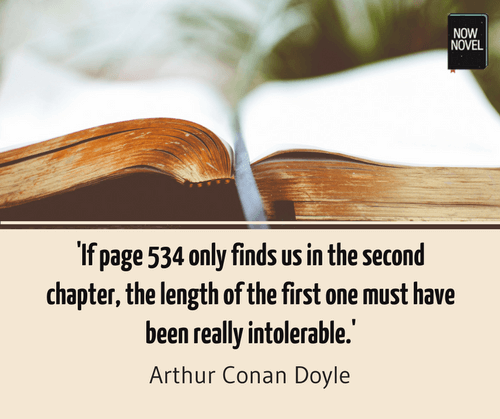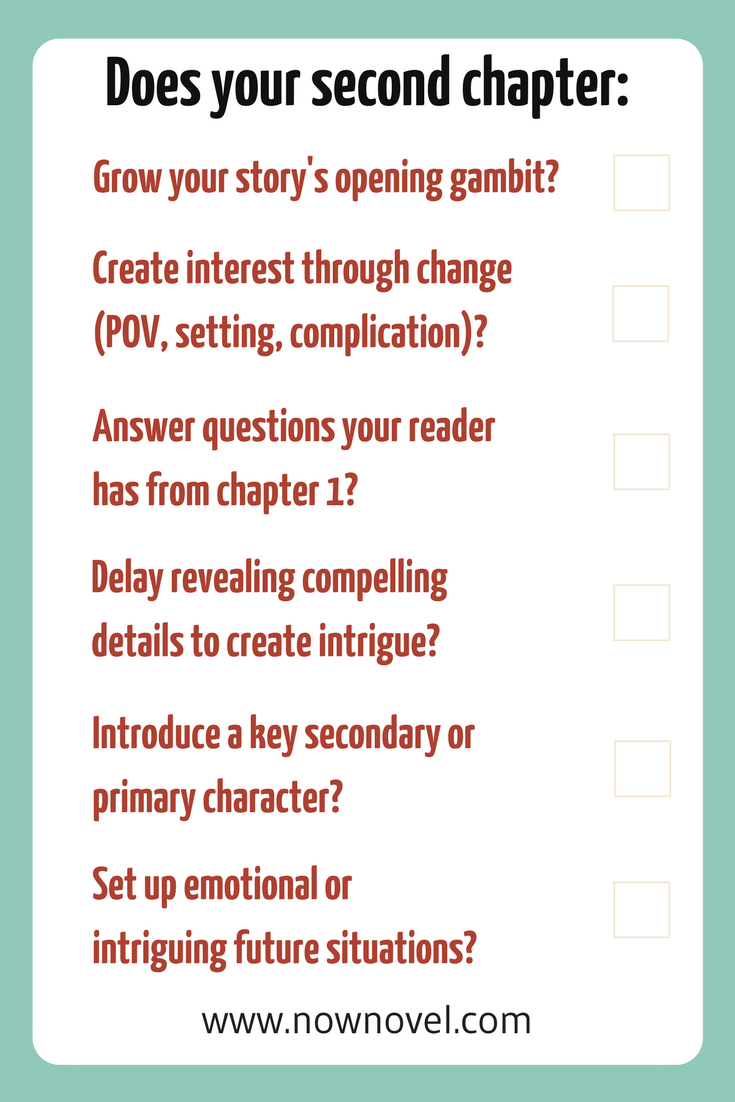The opening chapter of a book needs to hook your reader. How? By creating intrigue, suspense, lovable (or at least compelling) characters and interesting setting or action. Writing chapter one is a challenge, yet for many authors writing chapter two is the stumbling block - how can you develop further?
Here are tips for writing chapter 2, along with a second chapter checklist to make your story strong from chapter 2 onwards:
1. Expand or complicate your story's inciting incident
The inciting incident or 'call to adventure' is the action or scenario that sets your story in motion. It could be the launch of a Mars landing mission, the arrival of a mysterious letter or a death in the family. It's the situation that lays the foundation for change, conflict or discovery.
Once you have your first chapter, how do you write a strong chapter 2?
Think about how you can broaden or complicate the initial situation to bring in other characters, for example, with their own motives and desires.
Let's examine one or two examples:
Example 1: Love in the Time of Cholera by Gabriel Garcia Marquez
Chapter 1's inciting incident: In a port city in the Caribbean, Dr Juvenal Urbino, the husband of Fermina Daza, dies. There is an outpouring of respect from the community, including Florentino Ariza, a man whose passionate advances Fermina spurned 51 years before.
Chapter 2's development of Chapter 1's hook: Garcia Marquez switches the limited third person POV to Florentino's perspective. We read the history of Florentino's passion for Fermina Daza.
Marquez describes the first time Florentino saw Fermina when he delivered a telegram as a young postal clerk. He creates two unfolding arcs - what happens after Dr Urbino's death, and the lives of their younger selves.
We don't yet learn Fermina's response to Florentino's new intrusion into her life. We also have to wait to find out the full extent of what happened between. This is the background detail explaining what makes Florentino's visit stir up strong feelings.
Example 2: The Buried Giant by Kazuo Ishiguro
Chapter 1's inciting incident: In pre-Christian Britain, an old man named Axl and his wife Beatrice decide to go on a journey to find their long lost son. They're troubled by how everyone is forgetting the past in their village, as well as a nagging sense their son is awaiting their arrival.
Chapter 2's development of Chapter 1's hook: The couple sets off with walking sticks and bundles, struggling to remember the way to their son's village. They come across two strangers, a boatman and lady, in a ruined villa. They find out that the boatman has ferried couples on similar journeys and the woman complains to Axl and Beatrice the boatman tricked her and took away her husband during their own boat trip.
In the above examples, you can see there is a clear through-line from chapter 1 to chapter 2.
Marquez, on one hand, splits his story into two timelines to share what came before, and what might happen after, an emotional reunion.
Ishiguro creates a 'call to adventure' for his main characters in chapter 1, and shows, in chapter 2, the perils and the encounters of their journey (the boatman subplot symbolizes death, in one interpretation. It reminds us of the elderly protagonists' mortality and possible separation).
In both cases we begin to understand the possible complications in characters arcs, their dynamics, personal fears and feelings.
2. Decide where your second chapter should start
Where should chapter 2 start? Look at the opening of your first chapter. What is the biggest unanswered question?
In a sci fi novel, for example, your protagonist might be a scientist planning a dangerous, controversial experiment. Say, for example, your in chapter 1 your protagonist fights with a superior for authorization. You could begin chapter 2 with the moment they finally receive the go-ahead.
There are many interesting ways to begin second chapters. So it's natural for making the choice to feel daunting. Some ways you could begin chapter 2:
- A change of POV: Describe what another character is going through, in an arc linked to the scenario in your first chapter (for example, perhaps a junior scientist wants to stop the experiment at all costs due to valid fears)
- A change of setting: If there's a second location as important as your first, you could show the additional tensions or complications here. For example, if your first chapter describes the tough decisions a scientist must make at work, chapter 2 might begin with his arriving home from work and the issues there (such as marital tension), to show additional pressures affecting his choices
- A new complication: If a character has a difficult goal in chapter 1, what could make attaining this goal harder? Begin chapter 2 with this complication for immediate suspense

3. Answer some unknowns and create new ones
Plot is, essentially, the progression of old unknowns being answered and new or related unknowns emerging. For example, in the Marquez example above, unknowns we have from the inciting incident of chapter 1 include:
- How do Florentino and Fermina know each other?
- What is the nature of this knowing? (e.g. Are they friends? Former lovers?)
- How will Fermina react to the man's reappearance? How will Florentino behave? Why is their encounter in chapter 1 such an emotional experience for each?
Marquez proceeds to answer some of these compelling questions in chapter 2:
- Florentino met Fermina decades before when he delivered a telegram to her father one afternoon
- Florentino was infatuated at first sight. We see Fermina's first definite rebuff of his advances towards the end of chapter 2
- We find out Florentino repeats his 'vow of eternal fidelity and everlasting love' on Fermina's 'first night as a widow'. Finding out the older Fermina's complete reaction is delayed beyond the second chapter
By concealing some information - (the older Fermina's response), Marquez builds suspense. He creates new questions, such as 'what will happen now that Florentino is making overtures again, so soon after Fermina's husband's death?'
Think of questions you created in your first chapter. What can Chapter 2 answer to keep the story developing? What aspects can you delay revealing to keep your reader interested?
4. Introduce characters key to primary characters' arcs
When you're stuck on chapter 2, it's sometimes because you haven't thought further about your ensemble characters. Secondary characters who will help - or hinder - your main characters' progress towards their goals.
For example, when a melancholic, obsessive postal clerk is courting a young girl, how might her caretakers react?
Marquez shows this in chapter 2 of his novel. We meet younger Fermina's aunt, Escolástica, her ward and teacher (the name 'Escolástica' means one who teaches). Through the aunt character, Marquez foreshadows future chapters. The older aunt, wise to the way people in love behave, tells Fermina:
"Poor thing. [...] He does not dare approach you because I am with you, but one day he will if his intentions are serious, and then he will give you a letter." (p. 58)
The aunt's words make Fermina urgently want to know whether Florentino will give her a letter, and, if so, what it will say:
"...[O]ne night she awoke in terror because she saw him looking at her from the darkness at the foot of her bed. Then she longed with all her soul for her aunt's predictions to come true, and in her prayers she begged God to give him the courage to hand her the letter just so she could know what it said." (p. 58-59)
In this way, Marquez uses the figure of the teaching aunt to show how Fermina's desires and expectations form as a result of Florentino's advances. The aunt continues to be an advisor figure, telling Fermina when Florentino proposes:
"Tell him yes [...] Even if you are dying of fear, even if you are sorry later, because whatever you do, you will be sorry all the rest of your life if you say no." (p. 71)
Although Fermina does not take her aunt's advice, her words underscore the book's themes of unrequited love and the regret.

5. Hint at how the tensions chapter 1 introduces will unfold
We often talk of 'foreshadowing' in storytelling, yet you don't have to bluntly tell the reader 'Little did she know that [x would happen]'. Foreshadowing, hinting at what comes next, can be as simple as returning to the preoccupations of the first chapter, for example, and showing that they have not yet been resolved.
For example, towards the end of chapter 2 in Love in the Time of Cholera, Marquez writes:
'Florentino Ariza never had another opportunity to see or talk to Fermina Daza alone in the many chance encounters of their very long lives until fifty-one years and nine months and four days later, when he repeated his vow...' (p. 103)
By returning to the action of the first chapter - Florentino approaching the newly widowed Fermina Daza - Marquez shows the unfinished business of that scene. He creates anticipation for the drama and conflict (or love and harmony) that will result from Florentino's unswayed motives and desires.
Struggling to develop your story? Take a course that will help you write the synopsis for a book and your first three chapters. Includes detailed feedback from a writing coach as you progress.










Good article
Bappaditya Mukherjee - Over 7 years ago
Thank you, Bappaditya, I appreciate the feedback. Thanks for reading!
Bridget At Now Novel - Over 7 years ago
Yes, yes, YES. I cannot tell you how many wonderful first chapters I've read--including my own--only to see the second chapter devolve into numb noodling.
Elias Mc Clellan - Over 7 years ago
It happens :) I hope you're turning the numb noodling into a bolognese or other delight.
Bridget At Now Novel - Over 7 years ago
I love writing and this provides me with the next part of my book. Do you think this would still work I each character had a chapter from there perspective and then the next chapter afterward is chapter two (like the hero’s of Olympus). If not how do you think I could do it. Thanks for writing an excellent article ?
Minecaft Lover101 - About 7 years ago